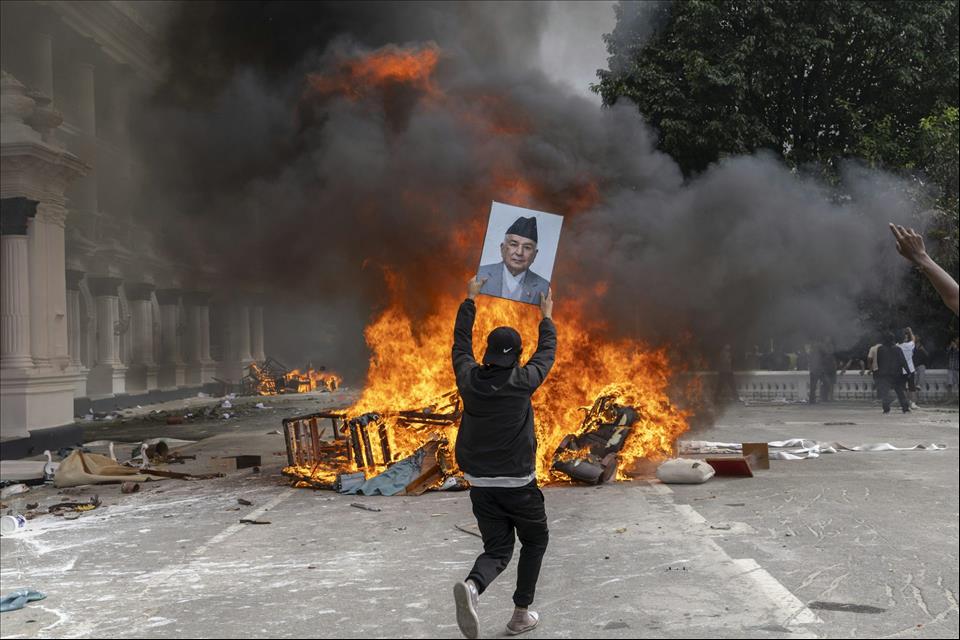Deadly Nepal Protests Reflect A Wider Pattern Of Gen Z Political Activism Across Asia
Some 22 people died and hundreds were injured within in a few hours in the clashes between protesters and police.
Prime Minister KP Sharma Oli and his cabinet ministers resigned in the face of growing public outrage and widespread criticism, both domestically and internationally , over the protesters' deaths.
What happened?Provoked by the deaths of the protesters on September 8, angry, young demonstrators burned down several government buildings across the country, including the parliament and supreme court.
Several politicians' residences were also set on fire, while leaders of major political parties went into hiding.
The Nepal Army is currently mobilising troops on the streets to take control of the situation, but power has not yet been officially transferred to a new government.
Unrest leads to protestsPolitical protests and public uprisings are not new in Nepal. The country's first mass uprising in 1990 (labelled“Jana Andolan I”) and the second in 2006 (“Jana Andolan II”) both called for major changes in the political system.
The governments that followed failed to meet the public's hopes for real reforms.
For the first time in the country's history, a protest of this size has been entirely led by young people from Generation Z (born roughly between 1997 and 2012). Out of nearly 30 million people in Nepal, about 40% belong to this generation.
Growing up in a digital culture shaped by internet and social media platforms, this generation has lived through Nepal's worst years of political instability and frequent government changes. There have been 14 governments in the past 15 years.
In 2015, Nepal shifted from a constitutional monarchical system to a federal republic system. But this massive change has delivered few improvements for everyday people. Despite some improvements in roads, electricity and the internet, inequality , political corruption , elitism and nepotism continue.
Making the situation even worse is an unemployment rate that exceeds 10% overall – and more than 20% for young people .
The social media ban that sparked actionIn a country where more than 73% of households own a mobile phone and about 55% of the population uses the internet , social media platforms are not only a source of entertainment and networking, but also a way of amplifying political voices – especially when traditional media is perceived as being biased towards political interests.
Nepal's Gen Z is using social media both as a social and political space. #Nepobaby is often trending on TikTok, while Instagram posts detail the lavish lifestyle that politicians and their children enjoy compared to the hard reality of many young people, who work low-wage jobs or have to leave the country just to survive.
On September 3, the government banned these social media platforms , citing a directive requiring companies to register in Nepal. The government justified the move as necessary to control fake news, misinformation and disinformation.
But Gen Z saw the ban as censorship. The frustration spreading on social media quickly turned into a nationwide uprising.
The government lifted the ban on September 8, but it could not save the coalition government.
Similarities in other countriesThe protests in Nepal mirror similar movements led recently by young people elsewhere in Asia, especially Bangladesh, Sri Lanka and Indonesia.
Like Bangladesh in 2024 , the young protesters in Nepal were frustrated with corruption and joblessness.
Similar to Sri Lanka's“Aragalaya” movement in 2022 , Nepal's protesters fought against inequality and nepotism, resulting in the collapse of the government.
And like Indonesia's student protests in recent weeks , the Nepali protesters relied on memes, hashtags and digital networks, rather than party machines to organise.
Where to from here?What comes next for Nepal is unclear. The army chief is now coordinating with Gen Z activists to set up an interim civilian government that will prepare for fresh elections.
This is a remarkable shift: the youth who shook the streets are being asked to help shape the country's political future.
Yet, challenges remain.
The young protesters are still a loose, leaderless network lacking the experience to run a state system. After an online meeting September 10, the protesters reportedly agreed to propose former Chief Justice Sushila Karki , now in her 70s, as a leader of the interim civilian government.
Nepal's key institutions, such such as the courts, bureaucracy and security forces, are still largely dominated by older elites, as well. Any attempt to shift power may face resistance.
Perhaps Nepal can take a lesson from Bangladesh's recent experience , where young protesters stepped in to help form an interim government, under the leadership of Nobel Peace Prize winner Muhammad Yunus.
Despite the challenges ahead, the uprising has provided a historic opportunity to fix Nepal's broken government system. But real change depends on how power shifts from the old guard to new leaders, and whether they can address the structural and systemic issues that drove young people to the streets.

Legal Disclaimer:
MENAFN provides the
information “as is” without warranty of any kind. We do not accept
any responsibility or liability for the accuracy, content, images,
videos, licenses, completeness, legality, or reliability of the information
contained in this article. If you have any complaints or copyright
issues related to this article, kindly contact the provider above.
Most popular stories
Market Research

- Edgen And Sahara AI Announce Strategic Collaboration To Pioneer Decentralized Validation In Market Intelligence
- Virtual Pay Group Secures Visa Principal Acquirer License
- Japan Buy Now Pay Later Market Size To Surpass USD 145.5 Billion By 2033 CAGR Of 22.23%
- GCL Subsidiary, 2Game Digital, Partners With Kucoin Pay To Accept Secure Crypto Payments In Real Time
- United States Acetic Acid Market Size, Growth & Forecast 2033
- Bitget Launches PTBUSDT For Futures Trading And Bot Integration





















Comments
No comment